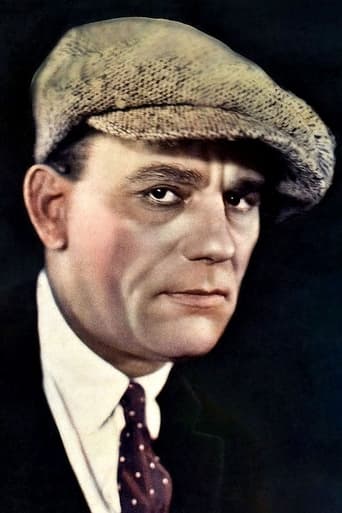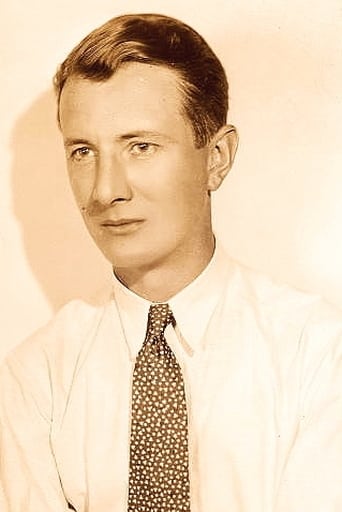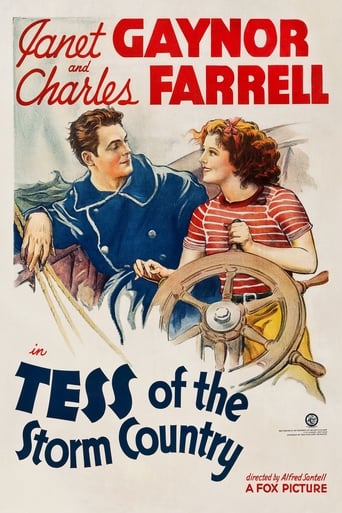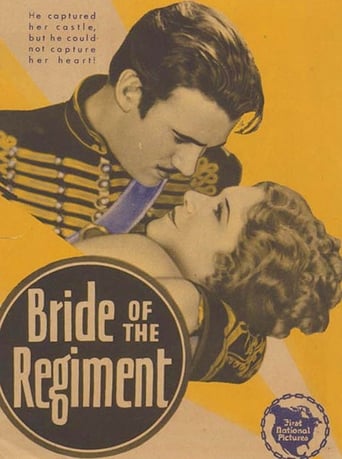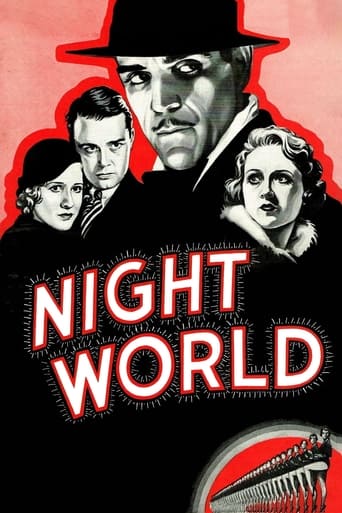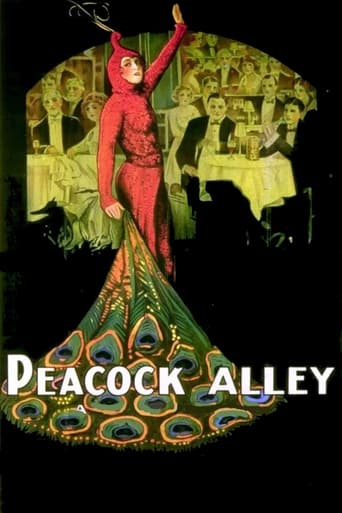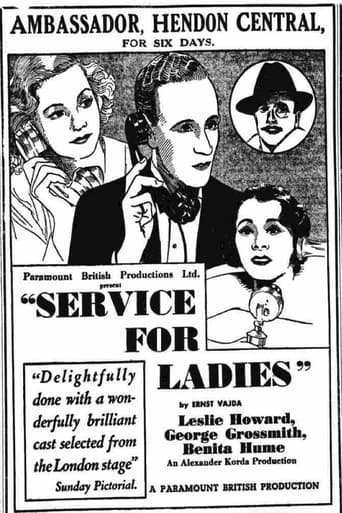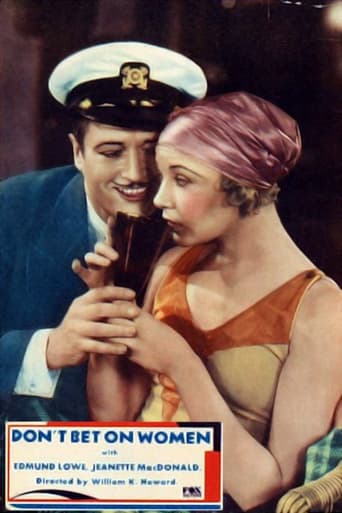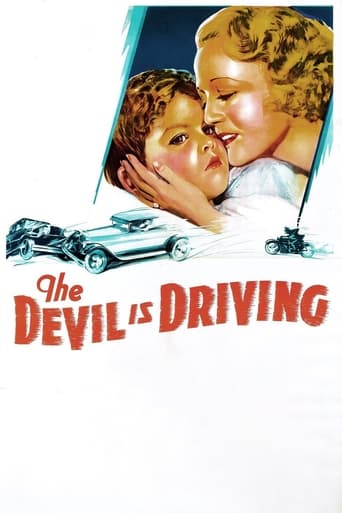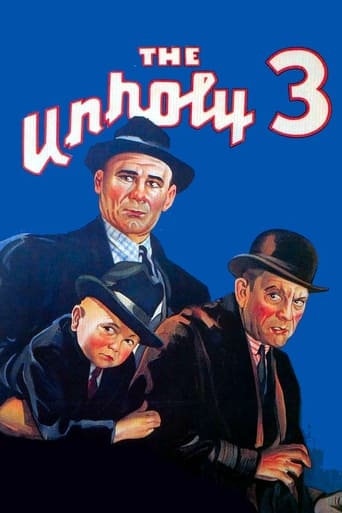

The Unholy Three (1930)
A trio of former sideshow performers double as the "Unholy Three" in a scam to nab some shiny rocks.
Watch Trailer
Cast
Similar titles
Reviews
Don't listen to the Hype. It's awful
It's funny watching the elements come together in this complicated scam. On one hand, the set-up isn't quite as complex as it seems, but there's an easy sense of fun in every exchange.
Very good movie overall, highly recommended. Most of the negative reviews don't have any merit and are all pollitically based. Give this movie a chance at least, and it might give you a different perspective.
This is one of the best movies I’ve seen in a very long time. You have to go and see this on the big screen.
Routed from a rather sleazy carnival sideshow (avec pickpocket) by the police, three actors reform as a theft ring with O'Grady's Bird Shop as a front. Customers who purchase the birds will soon experience home invasions. The three are Echo the ventriloquist (Lon Chaney), Strongman Hercules (Ivan Linow), and Midget a/k/a Tweedledee (Harry Earles). Echo poses as the old granny, Hercules pretends to be her son-in-law, and Midget – dressing in the baby's garb – acts as her very young grandson. In addition, the pert Rosie O'Grady (Lila Lee) is the sideshow pickpocket who later helps run O'Grady's; her dupe shop clerk and pet delivery boy is Hector (Elliott Nugent). There is even a "gorilla" to control the wild Hercules. Complications ensue when Hercules and Midget commit murder while stealing priceless jewels – against Echo's orders – and Rosie falls in love with Hector. So pinning the crime on Hector presents the impediment. There is both humor and suspense. See the scene when the detective visits the phony family around the Christmas holidays and picks up and shakes the "baby's" elephant that contains the jewels. Also, note the trial scene where Hector plays with a note unaware that it has to be read quickly to avert a deadly verdict.The film is a remake of the 1925 silent movie that plays almost the same, scene for scene, with a few minor changes. Lon Chaney and Earles each replicate their original roles. Chaney, as usual, is the master at acting (his only talkie) and makeup, and Lila Lee is appropriately cute and sexy. But much of the cast is mediocre. Because the Germanic Earles is incoherent, this writer had to view the movie in closed captioning to understand him (and the Latvian Linow). One additional point: the very last scene, with Chaney waving (to the viewers?) from the departing train seems to be symbolic of his impending death. Surely he must have known that he was dying, as he did less than two months after the movie's release.
THE UNHOLY THREE (MGM, 1930), directed by Jack Conway, offers a moment of truth for 1930 audiences and film enthusiasts today in witnessing what silent film legend Lon Chaney had never done before on screen - to be heard as well as seen. Between 1928 and 1929, movie goers were given the opportunity to hear their favorite silent stars speaking on screen for the first time. Some succeeded, others did not. Chaney and Greta Garbo were MGM's final holdouts, each making the transition to sound by 1930, while the great comic, Charlie Chaplin held out the longest, making his talking debut in THE GREAT DICTATOR (1940). Of all the silent screen performers, Chaney was something of a curiosity. The question is, "How would the man who created such legendary characters as "The Hunchback of Notre Dame" (1923) or "The Phantom of the Opera," (1925) sound on film?" For THE UNHOLY THREE, the wait wasn't very long. Minutes after the opening credits, the voice of Chaney is finally heard, with his first words being "Thank you, doctor. Thank you." For his role as a ventriloquist, Chaney offers his audience the opportunity to get to listen to his many voices as he did during the silent era with his many faces. Even for a talkie, Chaney continues to express himself with facial gestures as he did in the silent era, which comes off to best advantage.The story opens where Professor Echo (Chaney), a sideshow performer, entertains with his ventriloquist act. He is accompanied by Hercules, the strong man (Ivan Linow), Tweeledee (Harry Earles), the midget, and his girlfriend, Rosie O'Grady (Lila Lee), who roams around the crowd picking the pockets from observant patrons. Following a police raid that puts the Brandon's Old-Fashioned Museum out of business, the next scene reveals Echo planning a new racket with his associates, working as thieves in the night. As "The Unholy Three," Echo disguises himself as a kindly old lady who owns "Mrs. O'Grady's Bird Shop"; Rosie as "her granddaughter"; Tweeledee plays the baby in the cradle; and Hercules as Granny's son-in-law and baby's uncle. For security reasons, Echo takes his pet gorilla from the sideshow, keeping him in the back room in case any of his partners in crime, particularly Hercules, decides to betray them. Also among "The Unholy Three" is Hector MacDonald (Elliott Nugent), a young student studying to become an architect who's obtained a position in the bird shop in order to be near Rosie, unaware that her "relatives" are a gang of thieves. When Echo discovers Rosie's love for the young man, he decides to make Hector the fall guy by making him the prime suspect, causing his arrest for the series of crimes and murder while the gang seeks refuge in a cabin out in the country, with Rosie being held against her will.First filmed in 1925 that also featured Chaney and Harry Earles, with Mae Busch and Victor McLaglen as Rosie and Hercules, the same roles enacted here by the lesser known names of Lila Lee and Ivan Linow, who make fine, though not entirely great substitutes. While Chaney's voice(s) are articulate and clear, Earles is often hard to comprehend. Aside from this, Earles' character comes off both annoying and unlikable, which is probably the way he's supposed to be in the first place, being an instigator tempting Hercules to do things against his will. Hercules may be a strong man, but comes across as weak, considering his fear towards Echo's gorilla as well as failing to stand for himself against both Echo and Tweeledee. Twelve minutes shorter than the original, with certain scenes slightly altered or eliminated altogether, everything appears to occur very quickly, with detailed actions described in words than depicted with extended scenes. Director Jack Conway makes several attempts in duplicating Tod Browning's style as presented for the 1925 version. The use of silhouetted images of "The Unholy Three" as they gather together planning their latest caper is revised, along with elements of surprise and suspense where a police inspector (Clarence Burton) plays around with the baby's toy elephant where the stolen necklace is actually hidden, and another at the trial where Echo plants a note for Hector to read, only to watch him toying with it instead. Aside from these revised highlights, only the ending differs from the original, for reasons explained in the TV documentary "Lon Chaney, a Thousand Faces" (2000). Comparing these films, each presented on Turner Classic Movies, it's sometimes hard to determine which is the better of the two, yet, the ending used for the remake is more in a logical sense. See and judge for yourself. Although Chaney did became a success with his initial talkie, this was to be his one and only. Shortly after its completion, Chaney succumbed to cancer. Aside from Chaney's famous line, "That's all there is to life, folks, just a little laugh, a little tear," used in both movies, he finished his long and successful career with these final words, "I'll send you a postal card." The legend of Chaney ends here. The success and curiosity to THE UNHOLY THREE rests entirely on the man and the legend, even more so with this, his last hurrah. (***)
I had an afternoon free so I decided to watch the two versions of this Lon Chaney classic back to back, the original 1925 version directed by Tod Browning, and this later sound remake, which was directed by Jack Conway. It's the story of a crooked carnival ventriloquist (Lon Chaney) who teams up with the midget (Harry Earles) and strong man (Ivan Linow) for a series of robberies. Chaney dresses as an old woman and Earles plays a baby to perfect their scheme. In many ways this was a precursor to the popular Little Rascals/Our Gang short subject FREE EATS, where a couple of gangsters act as parents to a couple of little people dressed as infants, mistakenly referred to as "fidgets".I thought this was a wildly entertaining story either way, though it's difficult to fairly judge one film or the other when they're viewed so close together like this. There are pros and cons to both movies for me, though I think I would give this 1930 sound re-do the edge over the previous silent. Of course, this rendition is notable not only for the fact that it's Lon Chaney's last film, but also that it's his one and only SOUND film. I found that I preferred Lila Lee in the role of Rosie O'Grady here as opposed to the silent actress, Mae Busch. I also thought this one had a better courtroom sequence, as well as a more satisfying wrap-up for an ending. The sound film moves more briskly, while the silent felt slightly overlong (though the other was still quite good, and well-directed).It was an amazing treat to get to hear Chaney in his only talking film, and he actually sounded very much as I'd always imagined he would from his gruff exterior. It's essential to hear him doing the voice of the old woman, which was lacking in the original. On the other hand, it was sometimes difficult to always understand the dialogue spoken by Harry Earles (as Tweedledee the midget) and Ivan Linow (as Hercules the strong man). Jack Conway didn't do a bad job at all with this take, but I wouldn't be a bit surprised if most fans feel partial to the silent original just because it was directed by the legendary Tod Browning. My advice is to see them both! **** out of ****
The 1930 version of The Unholy Three boasts a distinction that guarantees it permanent special status among film buffs: the great silent star Lon Chaney made his only talkie appearance here, shortly before his death from throat cancer at the age of 47. And it's worth noting that this a faithful remake of the 1925 silent version in which Chaney also starred, thus giving us a rare chance to compare two performances by the same actor in the same role but in two very different formats, and to compare the handling of the same material before and after the coming of sound. (When Hollywood remade hits from the silent era the lead roles were almost always recast; parts once played by Doug Fairbanks would go to Errol Flynn, Valentino's would go to Tyrone Power, etc.) This summer I was lucky enough to see restored prints of both versions of The Unholy Three back-to-back at the Museum of Modern Art in NYC, and the experience was fascinating.The plot has been outlined in detail elsewhere, but briefly it involves the criminal career of a trio from the "carny" world: a ventriloquist called Professor Echo (Chaney) who masquerades as an old lady, a strongman, and a midget who disguises himself as a baby. A pet shop is the front for their activities. The trio is accompanied by a thief named Rosie, and a patsy named Hector they've employed who is unaware of their identities and plans. When a heist goes awry the members of the gang turn against each other, and violence erupts.Based on my recent viewings I feel the silent version holds up best. This off-the-wall material plays better in the silent medium, though I found it surprising how similar the two films are when viewed consecutively. When Jack Conway took on directing chores for the remake he must have had a print of the 1925 version available for close study, because there are several sequences in which he follows Tod Browning's editing rhythms and scenic compositions almost exactly. (One example of the latter: the shadow images of the title characters' silhouettes, thrown onto a wall while they plot together.) Even the dialog in the talkie frequently quotes the silent version's title cards verbatim. The biggest change comes in the courtroom finale, where sound allowed the filmmakers to utilize Prof. Echo's vocal talents more creatively. The outcome of the trial is also different in the remake, and somewhat more believable; although the audience at MoMA was respectful toward both films the verdict in the silent version was greeted with a burst of laughter.Why is the silent version the stronger of the two? Certainly Chaney gives a charismatic performance in both films, somehow carrying the viewer past numerous credibility stretchers through sheer force of personality. In the talkie version he demonstrates a fine voice, deep and a little raspy (possibly a result of his medical condition), not unlike Wallace Beery's. Chaney is terrific in both films and is the main reason to see the remake. The 1930 version follows the original so closely we can't blame the writers for going astray, nor are the film's shortcomings entirely the fault of director Conway, at least where visual style is concerned, for he followed Browning's original almost shot-for-shot. No, I believe the difference has to do with the aesthetic gulf between silent and sound film. We're willing to suspend disbelief when watching a silent movie: we'll accept crazy events in silent cinema that would be unacceptable, absurd, or even horrifying (in the wrong sense of the word) in the world of sound. Case in point: one of the most outlandish elements can be found at the pet store, where the proprietors offer birds, hamsters, rabbits -- and a dangerous gorilla, confined in a big cage. No one seems to consider the gorilla's presence unusual. In the silent version, we note this oddity and roll right along. But in the talkie, the gorilla is laugh-provoking; and it doesn't help that instead of the actual simian used in the silent film, the 1930 version features a man in a highly unconvincing ape suit, the sort of tatty-looking costume you'd expect to find in a Bowery Boys comedy.Talkies aren't just silent movies with sound added, they're a new world with different rules, especially where pace is concerned. Early talkies tend to drag, and this one is no exception. Although the remake follows the original closely it feels slower because director Conway and his colleagues hadn't mastered the new medium; they hadn't yet developed that rat-a-tat editing tempo we find in the gangster movies and musicals produced just a year or two later. And although Chaney handled his dialog deftly some of his co-stars did not: both strongman Ivan Linow and "baby" Harry Earles speak with thick accents that are difficult to understand.It's fascinating to see (and hear) Chaney in a talkie, but the remake is fairly slow going. The second Unholy Three is a film that requires patience for the average viewer, though it's a must for anyone with an interest in early talkies, the silent era, and, of course, its star performer. I only wish Lon Chaney had recovered and lived to make more films, once Hollywood's directors had grasped the demands of the new technology and learned to make slicker, more stylish movies that would have displayed his talents to better advantage.
